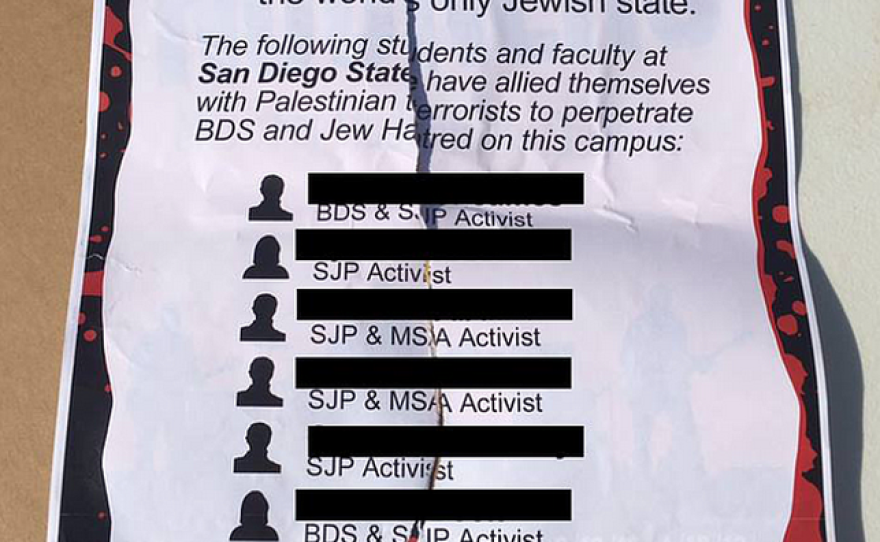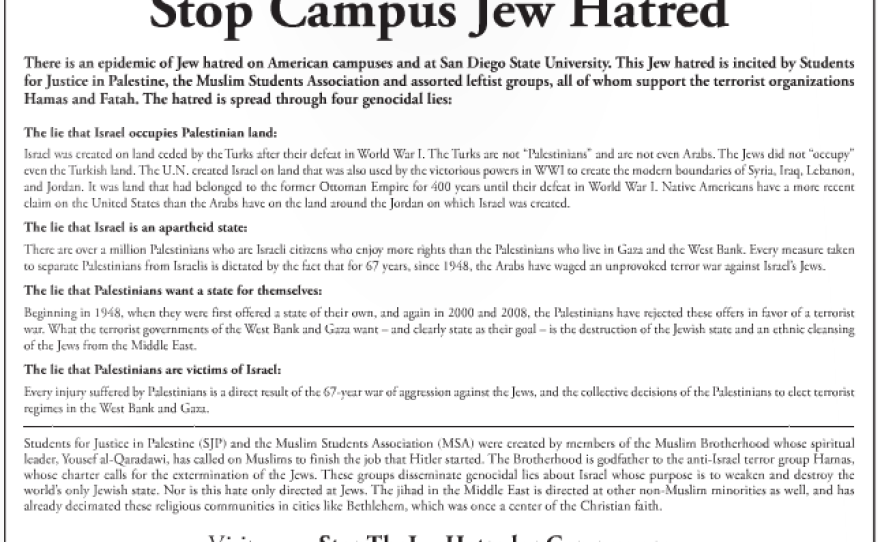Elliott has been blocked from leaving campus in a police car for nearly an hour students were protesting students response to the fire distributed on campus a fire apparently from the David Horowitz freedom Center a right week organization listed names of students and faculty members who allegedly support the protesters briefly surrounded Hirshman's car chancing When Owen reporter for KC are welcome to the program. And 70. Did you see any of these fliers on campus and it listed the names of several SDA students some of whom are Muslim. How many protesters were at this incident? When I first got there there were about 40 or 50 surrounding the police car and that probably grew to 70 or 80+ a few bystanders that stopped. University president Elliott Hurston was in a police car during event, was he in any danger? No. The protest A pretty peaceful town. But overall it seemed peaceful. They were getting very close to him. They were completely surrounding. Their blocking of removing? S. During a protest there was a moment of relative silence. There was fair that took place there. Tell us about that. At one point the crowd that silent and to people led a group of about a dozen or so Muslim students, in prayer. They all bowed on their knees and went through Islam in prayer ritual and it was a very peaceful demonstration. Apparently the university already issued an email to students that was critical of the flyer. It said it might discourage students from speaking freely on campus. What else did the student you spoke with one from Hirshman? They went to explicitly condemn the fliers. They felt he wasn't as critical as this incident as he wasn't another anti-somatic incident. Did the student ultimately get what they wanted from the president? Not completely. They did get an apology. But they wanted him to explicitly condemn those spires. He didn't do that at this confrontation. But this is what he said. We have done things inadvertently that have upset or hurt people. We're sorry. This point he was allowed to pass through the crowd and made into his office. When how under the protest go on? This stand off between him and the students lasted for over two hours. As you say apparently when the president made the apology, there was that applause that we just heard. To the resist certain amount of satisfaction. That doesn't completely satisfy the protesters yesterday. Know. I talked to one of them after Hirshman had left and he said they really want more explicit condemnation of the fires. They're actually going to meet with him privately at a later date. But right now there's no public form on the schedule. Tell me, anything else you know about this discussion at a later date. We're not sure but that can involve, they said it will include some the protest leaders that were there student leaders at the protest. They will probably be discussing what they think the administration should do after these incidents occur. And you just happen upon this protest, then you? Yes. I heard there is anger going on after the incident had occurred where the students were compared with terrorist, and I'll think anyone knew that was going to lead to present Hirshman being surrounded in a police car for long as he was. , Thank you very much. I've been speaking with Quinn out when reporter for KC are at a news assistant here at KPBS.
About 70 students Wednesday surrounded a police car with SDSU President Elliot Hirshman inside it and demanded he apologize for his response to fliers posted on campus listing names of students who “have allied themselves with Palestinian terrorists to perpetrate (Boycott, Divest, Sanction) and Jew Hatred on this campus.”
A Facebook post calling on people to join the protest called the fliers "blatantly Islamophobic."
Hirshman, who was sitting on the passenger side of the police car, eventually got out and apologized to those gathered.
“It was a very small and simple apology, but it was what we were looking for,” protester Osama Alkhawaja said.

According to the protesters, the posters began circulating on campus two weeks ago. In an email sent to students Tuesday, Hirshman said:
First, we recognize and fully support the rights of all parties to voice their positions on political issues, whether supportive or critical. We also understand that when parties adopt a specific political position they become responsible for their actions and these actions may produce criticism.
At the same time, we wish to raise an issue for our community to consider. It is possible that the practice of identifying the names of individual students who participate in controversial political discussions, solely for the purpose of identifying them as proponents of a viewpoint, could discourage students from participating in political discussions.
In this context, we write to encourage all members of our community to present their positions on important political issues, regardless of the nature of their position. We also wish to explicitly note that we strongly endorse our university policies protecting freedom of expression. We raise these issues to strengthen our tradition of vibrant discourse about ideas and issues and encourage all members of our community to participate in these discussions.

“These students feel very unsafe on campus right now because they're being targeted and they're being called terrorists and sympathizers of terrorist organizations,” said Fayaz Nawabi, a senior and a member of the Muslim Student Association at SDSU.
Tinoca and Nawabi, who helped organized Wednesday’s protest, said that university officials at UCLA condemned similar fliers that showed up at the Los Angeles campus.
“The Canary Mission put out this list of students throughout the entire U.S. that are part of the Students For Justice In Palestine, and are saying that these people are terrorists and they are secretly trying to take over America, or something of that disgusting, obvious defamation,” Nawabi said.
Wednesday's protest was peaceful, but San Diego police did respond to help SDSU officers control the situation. Hirshman remained in a patrol car for about an hour before getting out to speak briefly to the protesters.
Hanif Mohebi, executive director of San Diego's Center on American Islamic Relations, told the crowd it was "shameful" that Hirshman was not addressing the crowd.
"This is unacceptable," Mohebi said. "I honor our brothers and sisters of all faiths that have gathered to support out Muslim brothers and sisters."
Students on campus block police car carrying SDSU president pic.twitter.com/IOx61lGY0f
— Quinn Owen (@quinn_owen) April 28, 2016
The tone here just changed dramatically as protestors start Islamic prayer pic.twitter.com/KhcFjFIV8a
— Quinn Owen (@quinn_owen) April 28, 2016
Crowd goes silent as SDSU President talks to protest leaders pic.twitter.com/R2hzhUu1Nx
— Quinn Owen (@quinn_owen) April 28, 2016
Protest has wrapped up. Protest leader said SDSU president apologized and crowd let him through. https://t.co/iLAWWEWYYk
— Quinn Owen (@quinn_owen) April 28, 2016








